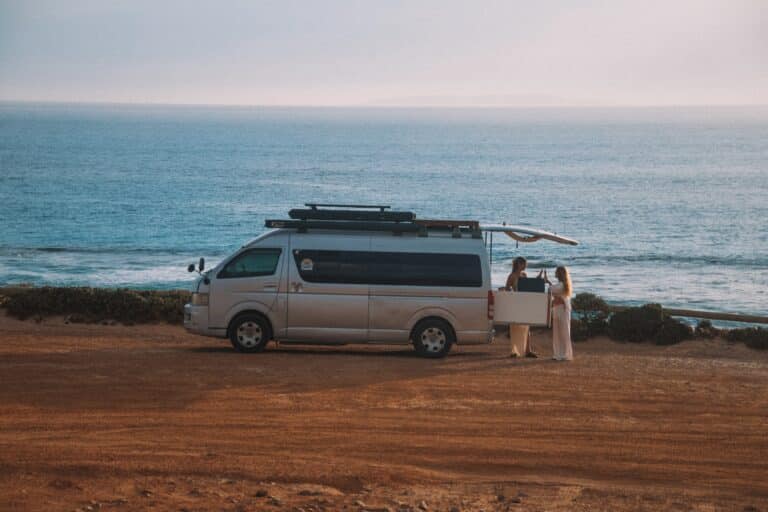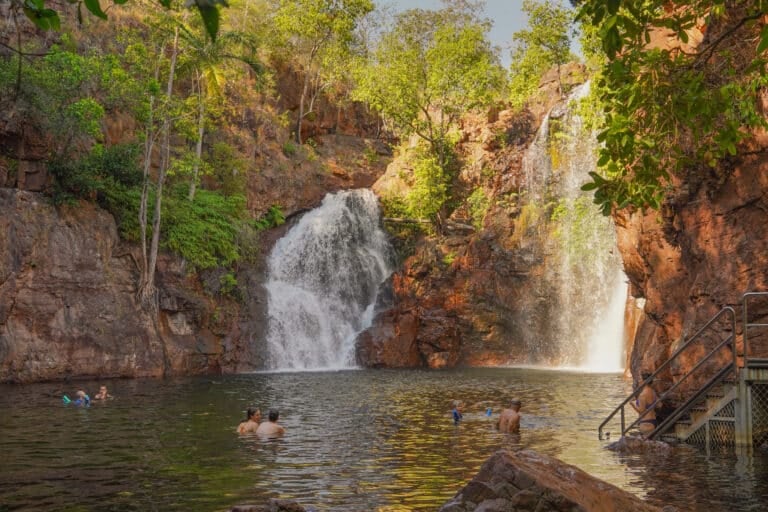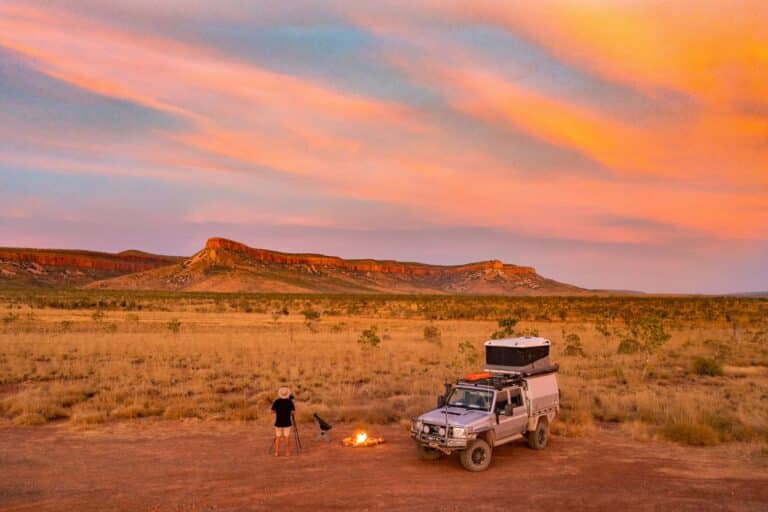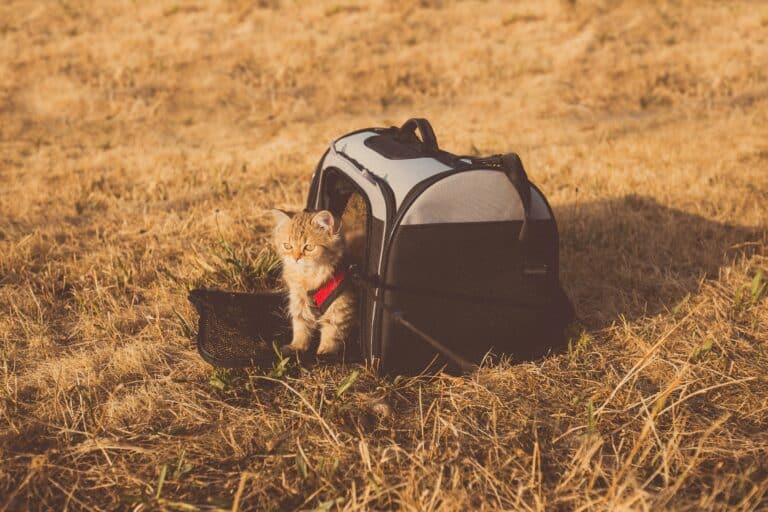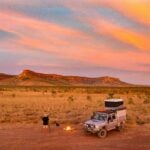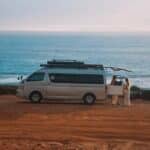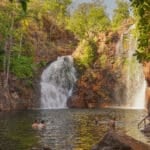Aah… the ubiquitous Aussie surf trip, where cutting loose used to mean getting on a wave, getting off your face and getting away from all that is civilised.
By Melinda Uys
The days of having a ‘secret’ wave are pretty much behind us with the advent of social media and apps updating us on surf and weather conditions every few minutes. Gone too are those hard-core surf camps – where a couple of shacks and the smell of hooch, long-haired blokes with ‘don’t stop here’ looks on their weathered faces and hushed whispers of “that point is always going off!” would signify an epic surf break nearby. Of course they still exist; but one of the benefits of living in our Australian nanny state is the forging of regulated camp areas so that for those of us who enjoy a wave, a modicum of comfort and just the odd beer, getting a spot near some curling saltwater isn’t the challenge it used to be.
Red Bluff, Quobba Station, Western Australia
The ‘King Waves Kill’ sign standing sentinel as you hit the Gnarloo Road on your way up to Red Bluff, graffitied with surf brand stickers and carved initials, does little to dissuade punters. Clearly this place is for the serious surfer and might be one of those gnarly camps of old. But even here, where the population of feral goats and the lack of washing facilities might produce the odd pong (and yes, a few greenish-tinged aromas can most certainly be smelt from time to time), it’s not a free-for-all of lean-tos and wild, salty-haired louts. Located at the southern end of the Ningaloo Reef system, this is one of the first stretches of coastline going south where the Indian Ocean can finally smack its way right into the beach. The headland provides a perfect geological barrier for the swell and a left-hand wave peels off with a regularity that surfers wet dream about.
We managed to snag a clearly-defined unpowered site overlooking the beach and bluff at the Station-run campsite. Shell wind chimes grace the inside of the palm frond lined drop toilet, a wooden bar is set up on the fence separating us from the dunes and glorious sunsets and the fire pit is cemented rock – built to shield the flames from the prevailing wind.
Whales swam to within 100 metres of the beach, we caught threadfin salmon off the cliffs close to camp, and we surfed that relentless break on the only day that afforded a six-foot swell. It was 15-foot most of the time – absolutely out of our east coast surf skillset and apparently a ‘small-wave week’ for the couple of Station kids whose knock-off time from their tutor doubled the number of those in the line-up. The shore dump on the beach is not for the fainthearted either… being just as relentless as those massive waves. Our camper rattled and my head ached from time to time with the boom of that Indian Ocean banging into the continent. But those sunsets, the wild untamed surrounds of gnarly scrub, sand and salt, and the small community of slightly dishevelled surfers, east coast trekkers and Station family meeting at the shop for a pizza or in the ocean for a wave… it all felt very civilised.
Getting there: Of the 140 kilometres from Carnarvon to Red Bluff, it’s bitumen until Gnarloo Road and the King Waves Kill sign – where the next 80 kilometres is dirt and only graded a few times per year and can become deeply corrugated and sandy in sections. Check with the Station or Main Roads before entering.
Staying: There’s a variety of unpowered camping sites throughout the grounds. Palm frond humpies and safari tents are also available. Apart from drop toilets, you must be completely self-sufficient although there is a small shop selling essentials and (at certain times) pizza and burgers.
Best time of year: May through to August produce the best waves, and more reasonable temperatures.
More information: Pets are permitted but under strict conditions.
Cactus, South Australia
The beaches of Cactus, Caves and Castles on Point Sinclair used to be a closely guarded and (at times) violently defended secret – such was the desire of some local surfers to keep the waves uncrowded by a bunch of ‘touros’. In 2013, however, the secret was out when the area was inducted into the Australian National Surfing Reserve list and officially recognised as a place of great ecological and sporting importance.
According to its caretaker of more than 30 years, Ron Gates, the isolated Cactus campground near Point Sinclair was ‘feral’ when he first visited in the 1980s. “People here didn’t care about anything, they were ruining it and just hopping out for a wave when it turned on.”
Today it’s a very different story. Sites are carefully marked out and maintained and you’re more likely to encounter hordes of ‘Old Guys Rule’ T-shirt wearing retirees on their annual surf trip, checking in with the wife somewhere between the last surf and craft-beer o’clock, than groups of feisty 20-somethings with rubbish scattered in a 20-metre radius around their camp.
Ron is passionate about the ecology of the area. Even walking off the fenced tracks onto the dunes is prohibited, as my children found out. Tiny tell-tale footprints and Ron’s gnarled eye looking steadily at her led my four-year-old to admit to climbing through the fence and onto the dune very quickly. Ron quietly replied, “I saw. Don’t go back in there…” going on to explain the significance and fragility of the dunes.
Later we sat on the rocks and watched the waves peel in over Cactus and Caves, feeling like we’d been plopped into the middle of a Tim Winton novel with the colour palette of whites, blues and yellows and the surf as epic as he describes. My husband had been pretty reluctant to hop in the water, claiming he only had a spring suit against the ridiculously cold water. To be fair, we’d watched our neighbour up at camp pour steaming water from his kettle straight into his wetsuit before heading out for a wave; although the numerous plaques to surfers who’d been attacked by sharks weren’t doing his bravado any good either. By the time he’d plucked up enough courage to head out, the wind had gotten into the swell and those beautiful waves were all blown out. We headed back up to camp and spent the hours over dusk sipping red wine around one of the communal campfires, discussing global economics with a banking executive up on a surf trip from Adelaide with his adult son. Nope, no drop-outs here.
Getting there: Turning off the Eyre Highway from Penong there’s about 21 kilometres of generally well-maintained gravel road.
Staying: Large and small unpowered campsites are available; with wonderful flush toilets,
a communal camp kitchen and a (mostly) cold shower (bore water). Some wood is provided.
The nearest shop is in Penong.
Best time of year: The surf here is fairly consistent although wind direction definitely plays a part. It gets very hot in summer and very cold in winter!
More information: Pets are permitted but under strict conditions.
Lennox Head, NSW
Twenty years ago Lennox Head was a tiny coastal hamlet with a pub, a pizza shop and a seemingly large population of black-clothed sun-bleached grommets delinquenting the streets when the surf wasn’t pumping. Now, there’s still a lot of sun-bleached hair getting about, but the town is more seaside beach chic than scary surfer-dom.
Being one of the first areas to be given the title of National Surfing Reserve tells of the significance of Lennox Head for the catching of waves – especially with Byron Bay (a surfing mecca) only 20 kilometres up the road. Providing not only those huge barrels for the experienced around the rocky headland, the open beaches have created a space for surf schools for those who don’t really want to stare death (in the form of a big wave and hard rock) in the face.
The North Coast Holiday Park, located just north of Lennox Head, is on the shores of the tea tree scented and stained waters of Lake Ainsworth. Grassy sites are checkerboard in regularity; narrow bitumen roads are roamed by gangs of children on scooters and bikes; boards are locked in their bags to cars, campers and caravans; whilst noise, tariffs and lengths of stays are closely monitored.
There’s a great selection of cafes and bars a few hundred metres away, with a patrolled surf beach across the road and the super-safe waters of the lake to swim in just out front. It certainly isn’t the wild and ruggedly beautiful west coast – but watching the kids paddle in those healing waters, sipping on a latte, a fresh croissant in hand while my husband paddled about in the Lennox froth and foam… there was definitely nothing feral about that.
Getting there: Bitumen all the way. The park is one kilometre north of the Lennox Head township.
Staying: Suitable for large and small rigs.
There’s a variety of unpowered and powered sites on slabs or grass, and cabins; with a great camp kitchen and all the usual amenities. The park fronts onto Lake Ainsworth although there is no direct camping on its shores.
Best time of year: It’s fairly temperate here all year round, but the surf is most reliable during the winter months.
More information: Pets are not permitted.





